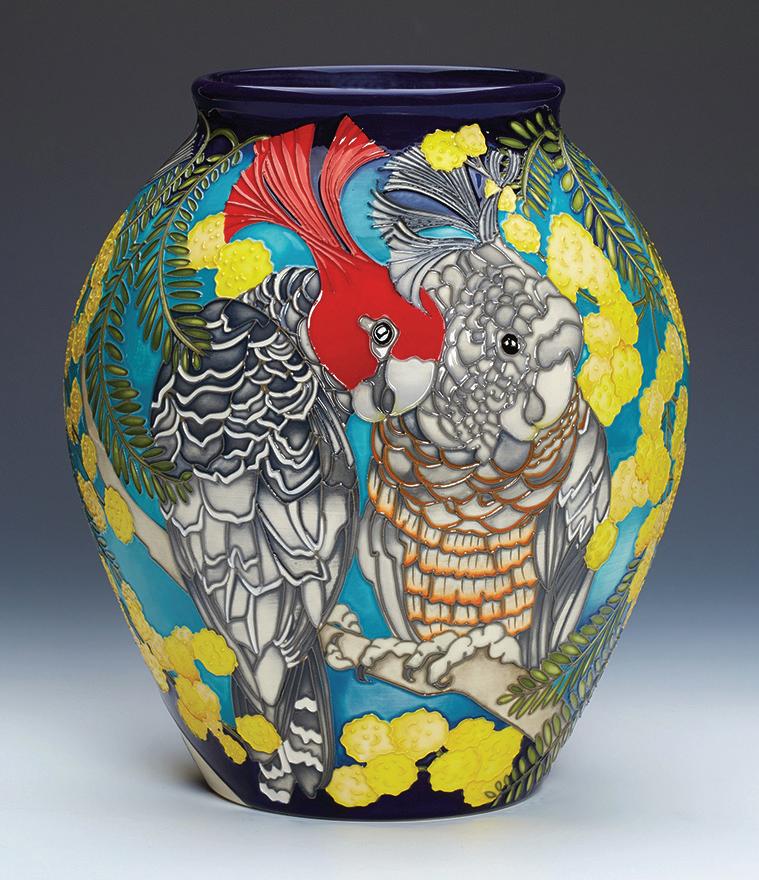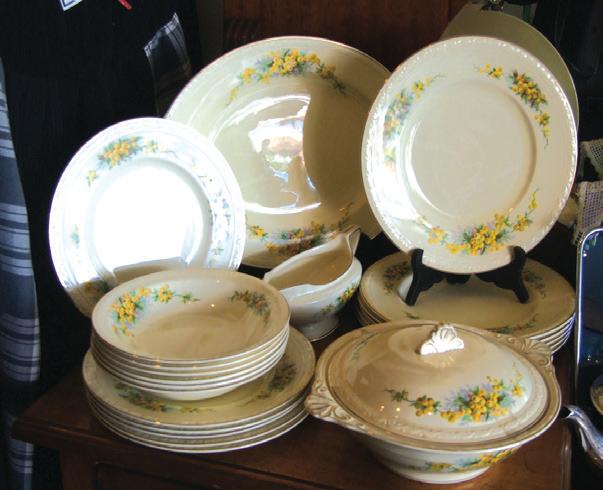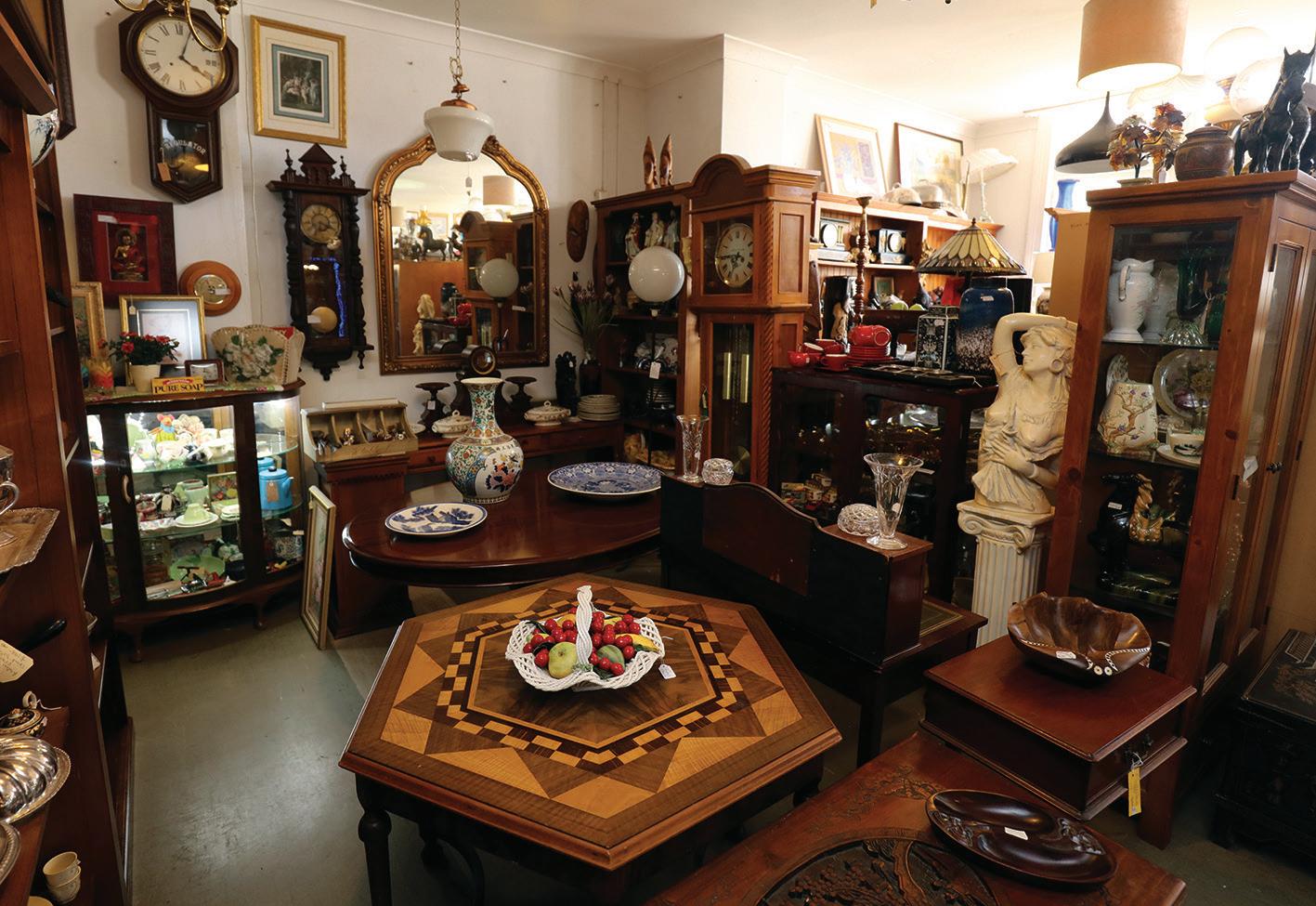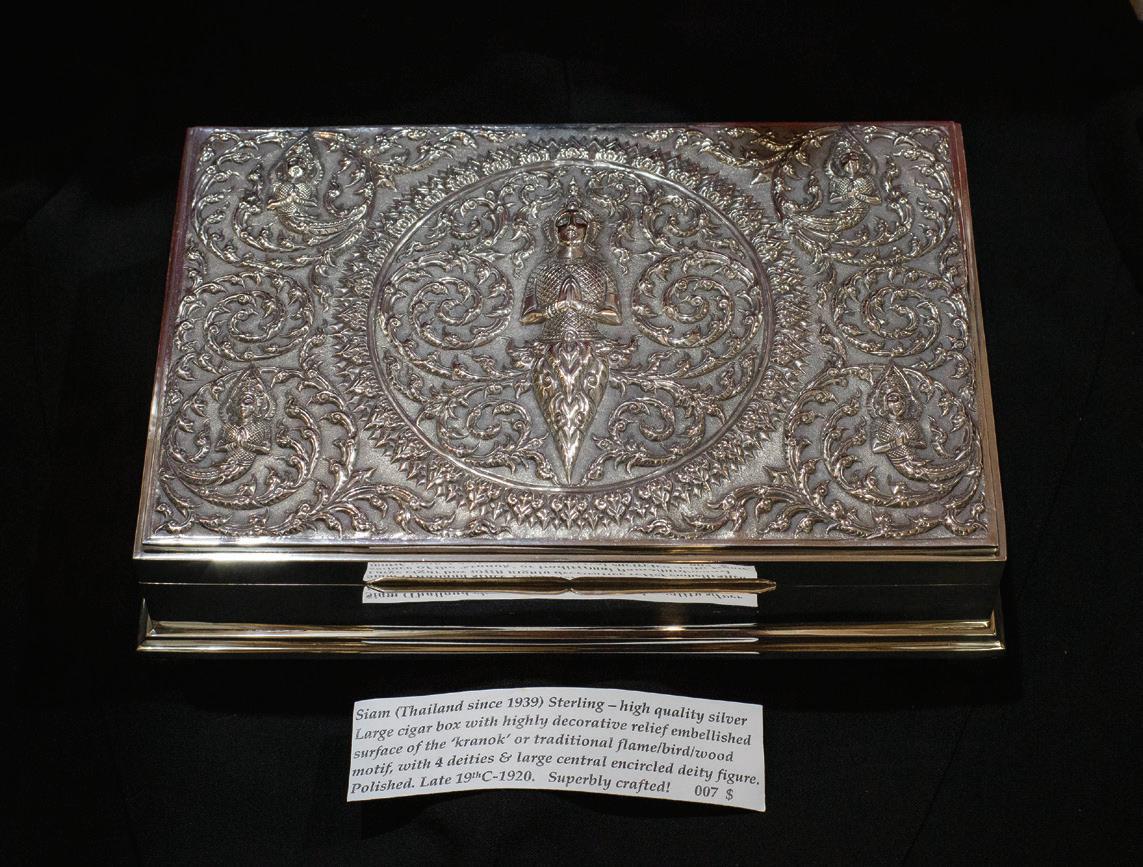
18 minute read
Botanists Way
My good friend Denys (he’s French born) with whom I enjoy good conversation and difficult bushwalks is immensely enamoured of the Australian bush. He even lives on a several acre property adjoining the National Park. Most days before or after work he can be found investigating all manner of plant and creature life, generally with camera in hand. He is a photographic enthusiast and has some amazing camera equipment. We get on so well because we share large helpings of curiosity, about everything we encounter.
Recently during his wanderings Denys spotted the beautiful butterfly pictured below. He had not seen this specie before and shared his discovery with me. I was unable to enlighten him so off he went to research. It turns out Graphium macleayanus of family papilionidae and tribe leptocircini is not rare in the Blue Mountains, perhaps just shy.
Local author and bookseller Craig Stanton has written a collection of scary tales based in the Blue Mountains, published by MoshPit Publishing.
The book is titled Mountain Deviltry and weaves fictional stories of ghostly events and horrible happenings in the region, mixing creeping horror with a strong dose of humour.

Born in Katoomba, Stanton has lived here on-andoff during most of his life, including the last 12 years, working to source and sell books. He has a Master’s degree in Creative Writing from the University of Technology Sydney.
Stanton also works in the comics field, having written for the Swiss-based comic series “Yuggoth Rising”.
View to Mount Banks and the Grose River from Govetts Leap Lookout. Photo by Denys Joannes
This species is found in forest edge habitats including rainforest clearings and glades, deciduous woodland, parks and gardens. In tropical Queensland it is primarily a mountain butterfly, but in New South Wales and Tasmania it can be found commonly down to sea level. The genus Graphium is widespread in the Old World, with 35 species in the Afrotropical region, 14 in the Oriental region, 6 in the Holarctic ( south & west China ) and 20 in the Australian region.
The fully grown caterpillar is pale green with faint whitish spots. It is humped at the thorax, which carries a pair of short tubercules at the widest point. The body tapers towards the head and tail. As with all Papilioninae, there is an extrusible soft fleshy orange-coloured organ behind the head, which emits foul-smelling odours as a means of defence against predators and parasitoids.

Males commonly imbibe mineralised moisture from bare ground, especially in stony or rocky areas. Females seem to be much scarcer than males, and are usually only encountered when they nectar at the flowers of trees, bushes or herbaceous plants.
Sometimes on hot mornings large numbers of males, and much lower numbers of females, can be found “hill-topping”, i.e. gathering at what is effectively a lek, on a hilltop or mountain ridge. This behaviour is common among the Papilionidae and other butterfly families. It enables low density forest-dwelling species which would otherwise have difficulty in locating mates, to home in on a meeting place.
Faulconbridge Antiques, commission exclusive designs from world renowned Moorcroft Art Pottery.
This is the first time in nearly fifteen years an Australian Moorcroft retailer has commissioned their own exclusive designs from this art pottery company which is based in Stoke-on-Trent England. The Gang Gang Cockatoo and Blackheath Rhododendron have been immortalised in a range of small limited edition art pottery pieces.

The Gang Gang Cockatoo, one of Australia’s most charismatic birds is painstakingly outlined in three different panelled images in liquid clay, the artwork is hand painted on the pretigious Moorcroft shape under the skilled direction of designer Kerry Goodwin. Kerry has designed the pair of male and female Gang Gang Cockatoos as they perch proudly on Golden Wattle with heads tucked in tightly together. A demure slate grey body and a scarlet red head and crest on the male bird, with the feathers of the underparts of the female edged in riveting salmon pink and mustard yellow to contrast against her dark grey body, against the blue background.”
Faulconbridge Antiques have also ensured that the 50th birthday celebrations of the Gardens of Bacchante Street, Blackheath are set in clay with their Blackheath Rhododendron design. The Campbell Rhododendron Gardens were created in 1970 on 18.5 hectares of Australian bushland and are managed and maintained by the volunteers of the Blue Mountains Rhododendron Society of NSW.
“Moorcroft designer Emma Bossons weaves a soft, fairy-floss pink rhododendron from the gardens on the highly collectable Moorcroft ginger jar shape, vase and lamp base with a matching shade, lifting the pale-pink blooms in a graceful ascension into powder-blue.
The stunning art pottery pieces are only available to purchase from Faulconbridge Antiques and are sure to sell out quickly due to the small edition sizes!

Late 19th century Bombe Vitrine


Art-deco alabaster-marble Polar Bears lamp

Late 19th century Sevres lidded vases

Baccarat crystal enfants twin hurricane lamp

OPEN 7 DAYS 9.30 - 5pm - Phone 4751 7627 448a Great Western Hwy, Faulconbridge www.faulconbridgeantiques.com.au
Susanne Hosking Antiques Blackheath
One store yet so much variety
22 Govetts Leap Road with a huge range of quality jewellery
This antique shop carrying Susanne’e name is proving popular with visitors and locals alike. At 22 Govetts Leap Road, it is open 7 days from 10am-5pm.
Those who enjoy a rummage are finding all sorts of gems from the large range of beautiful China and vintage collectables to the fine range of 1920s to 1950s costume jewellery. There is furniture from Victorian to Retro and a great selection of Oriental collectables.
This is a fun store where you will see a whole world of surprises. Susanne has just received a new range of gold and precious stone jewellery including diamond, ruby, sapphire and pearl. China, collectables, jewellery, furniture, clothing and more. Ph: 0428 042 965 With so many antique and collectables shops across the Mountains, many choose to specialise in particular fields. Add to this the numerous antique fairs and markets regularly occurring in the area and you have a collector’s treasure trove. Below is a sample from the many antique retailers in the mountains.
At Faulconbridge Antiques browse through an eclectic array of high quality antique porcelain, glass, furniture and other interesting pieces. The shop specialises in Royal Worcester, Belleek, Carlton Ware, Crown Devon, Shelley, Clarice Cliff, Royal Albert porcelain, late 19th and early 20th century glass, including Thomas Webb, Lalique, Tiffany and many other makers. Contact: (02) 4751 7627.
Located at the entrance of Wentworth Falls village, Rotate Interiors is a must visit for anyone looking for beautiful and classic pieces for the home. With three rooms full of restored antiques, lamps and decorative items, and with unique new items arriving weekly, there’s sure to be something to tempt and inspire you. www.rotateinteriors.com
Nestled in the picturesque village of Leura, Bygone Beautys Treasured Teapot Museum & Tearooms is home to the world’s largest private collection of teapots. It is also the largest private emporium of antiques and collectables in the Blue Mountains. Turn back time as you browse antique jewellery, furniture, fine china, dinner services and toys. www.bygonebeautys.com.au
Adjacent to the clock arch over Katoomba Street at the top end of the street, you’ll find antique furniture, second-hand wares, memorabilia, gardenalia, French Linen, ironware, china and porcelain – all this and more is on offer at the elegant old two storey post office, which is now Katoomba Vintage Emporium. Contact: (02) 4782 6996.


At Blackheath, The Victory Theatre Antique Centre presents sixty dealers over two floors with wares ranging from jewellery, books, vintage clothing, paintings, dolls, ornaments, light fittings, fine china and porcelains, through to furnishings and furniture, and boasts the greatest variety of stock in the Blue Mountains. www.victorytheatre.com.au
KATOOMBA VINTAGE EMPORIUM


Amazing collection of furniture, collectables, clothing, linen, jewellery, crockery, clocks and many more categories. Rare and unique items, small and large on two floors set in the imposing heritage listed former Katoomba Post Office.

59-61 Katoomba Street, Katoomba (ample parking at rear) Open seven days. Ph: 02 4782 6996 or 0418 794 323 www.katoombavintagemporium.com.au


Since it was turned from a picture theatre into an antique centre, The Victory Theatre has stood like an Art Deco cathedral of treasures in the centre of Blackheath. Tucked behind the much loved Victory Theatre cafe, the entry to the antique centre becomes a surprise portal to another era, with a gathering of over 60 stalls of all things past.
One can almost feel the ghosts of the past walk with them around the store as objects from every era jump out at you, competing for your attention. Beatles memorabilia, records, strange paintings of bullfighters, original European birdcages weaponry from eras where we lost too many men and other pieces of history clutch at your consciousness to respond and feel. Precious items almost too delicate to hold rest in locked cabinets waiting to be held once more and furniture that was born before mass production waits to tell you its story.
Some very exciting new stallholders have recently joined the display at Victory Theatre. One has brought a container load of antiques fresh from England and another is an exciting space upstairs taken by Hat Hill Gallery with a great selection of new and quality used records, Cds, Dvds, books and fine art prints and cards. 19-21 Govetts Leap Road, Blackheath. P: 02 4787 6002 www.victorytheatre.com.au
Victory Theatre Antique Centre


Over 60 stalls of beautiful and varied pre-loved items
On two huge levels in this fabulous old theatre building you will find so many treasures. There is jewellery, books, collectables, furniture, china, clothing, lights, lamps, toys, decorator items, mirrors, even a convict used ball and chain was recently sold. So if you’re looking for something it’s probably here and if you want to be surprised, this is where to come.
19 - 21 Govetts Leap Road, Blackheath Ph: 02 4787 6002 www.victorytheatre.com.au Open 7 days from 10am - 5pm

Silver cigar box (left) and silver bowl (below) available at Sage.
Sage
A sumptuous display of splendid quality antiques boasting Moorcroft, Lalique, Daum, Lladro and Royal Worcester, greet you at the entrance of the Victory Theatre Antiques Centre. Five lavishly bedecked cabinets under the name of SAGE showcase quality items that will always maintain their value. A strikingly impressive and richly coloured selection in ceramic and glassware offers vases, dinner ware, display plates & chargers, tea sets, comports, bowls, jugs, tiles and figurines. Royal Doulton, Wedgwood, Shelley, Aynsley, Royal Crown Derby, Minton, Rosenthal, Herend (Hungary) Capodimonte (Italian), Royal Copenhagen (Danish) - all can be seen in the SAGE shop.
Additional to these renowned European and English companies are American Satin Ware, Lladro figurines, two shelves of appealing ‘animalia’ ceramic ware and a beautiful selection of Japanese Satsuma ceramics – a must to see for its delicate hand painted golden detailing. Australian glass artists such as Chris Pantano, are also showcased. Exhibited internationally and throughout Australia, his work embraces the wonders of the Australian environment and rainforests.
A seasoned antique dealer, SAGE is a member of the Silver Society of Australia. Established 30 years ago, it researches worldwide and Australian collections, silversmiths and collectables. One very special item on display in SAGE’S silver cabinet is an exquisite Georg Jensen (1866-1935 Danish) Tazza Grape Comport, a post 1945 piece of the original designed in 1921 (pictured). SAGE’S silver cabinet shows a wide range of impressive 19th to 20thCenturies pieces from bon bon baskets to coffee pots and cutlery. The Victory Theatre Antiques Centre is open 7days a week from 10-5.

For many thousands of years, the Blue Mountains area has been home to Aboriginal people. Today, our region’s Aboriginal community is vibrant and welcoming; its culture representing an important connection to the past and a legacy for the future. The Blue Mountains region spans large parts of the traditional lands of the Gundungurra and Darug language/tribal groups.
Unfortunately, post-European contact with Aboriginal people in the region after the crossing of the Blue Mountains in 1813 – together with subsequent expanding settlements – brought a negative impact on the existing Mountains Aboriginal communities whose numbers dwindled.
Two hundred years after Europeans crossed the Blue Mountains there are still many Aboriginal people with traditional connections to this ‘Country’ living in the region. According to the 2011 Australian Bureau of Statistics Census there were approximately 1,320 people who identified as Aboriginal and/or Torres Strait Islander living in the Blue Mountains LGA with more than half of the community under the age of 24.
Today, a number of Aboriginal organisations support the local Aboriginal community, and have a strong dedication to the preservation and continuation of Aboriginal culture in the region.
The Blue Mountains area boasts a significant legacy of Aboriginal historical connections with many Aboriginal sites, one estimated by archaeologists to be over 22,000 years old. Many cultural sites in the Mountains not only illustrate Aboriginal cultural heritage but are also an important legacy for present and future generations of Aboriginal and non-Aboriginal people.
One of the current declared Aboriginal Places in the Blue Mountains LGA includes ‘The Gully’ – a place where Gundungurra, Darug and other Aboriginal and non-Aboriginal people lived as a fringe community from around the 1890s onward over a number of generations. In 2002 ‘The Gully’ was declared an Aboriginal Place under the legislation of the National Parks and Wildlife Act.
Aboriginal Ancient History - All dates listed as BP (before present). We thank Waradah Aboriginal Centre for their generosity in sharing with us the article below which was created by their research.
The information below is researched and documented by non-Aboriginal historians. The “Dreaming” of Aboriginal people in Australia indicates that they have always been here since “the dawn of time”. This is evidenced by their cultural dance, stories, artwork and Dreamtime Lore, for example the Rainbow Serpent and Creation Stories.
• 120,000 Analysis of pollen and charcoal giving a date of 120,000 BP (before present) suggests that people were using fire to clear land in the Lake George basin in the Southern Tablelands of NSW, about 30 kms. north-east of Canberra. • 68,000 Current estimates for the arrival of Aboriginal people in Australia • 60,000 Age of Lake Mungo 3 human remains (age range between 56,000 and 68,000 years), south-western NSW, 987 km west of Sydney. Footprints discovered at Lake Mungo are believed to be 23,000 years old. Mungo Man, thought to be the oldest human uncovered on the Australian continent. Mungo Man is between forty and sixty-five thousand years old, and Mungo is one of the oldest known continually-inhabited places outside Africa. • 56,000 Suggested age of two north Australian sites (Nauwalabila and Malakunanja, about 300 kms east of Darwin). • Archaeological evidence suggests that a rock shelter was used by people at a site in Arnhem Land (400 kms east of Darwin) in the Northern Territory. They used stone tools and red ochre probably to prepare pigments for rock painting or body decoration. • 45,000 Rock engravings made in South Australia - the earliest dated petroglyphs. (rock engravings). outside Africa. • 40,000 Clear archaeological evidence that Aboriginal people have been living in south-eastern Australia e.g. Lake Mungo National Park, NSW. • The oldest dated art in Europe is 40,800 years old and was found in the El Castillo cave in Spain. It contains many red hand stencils, similar to stencils found in Australia. • 35,000 Age of oldest known camping site found in the Pilbara region, Western Australia, near the Jugaling Rock Shelter. The site belongs to a mining lease jointly owned by Rio Tinto and Hancock Prospecting. Both companies refuse to permanently exclude the site from mining. • 30,700 Age of fireplaces (such as underground oven) at Lake Mungo National Park, NSW. • Aboriginal people living at the Keilor site (20 kms north-west of Melbourne) in Victoria.
• 30,000 Oldest evidence of bread making in the world at Cuddy Springs (ancient lake located between Marra Creek and Macquarie River, near Carinda, western NSW). • A man from the Lake Mungo area (south-west NSW) is buried in a shallow grave. His forearm bones are stained pink from ochre. This is one of the earliest known burials of a distinctly modern people. • Aboriginal people were living around the now extinct lakes of the Willandra Lakes system. Evidence shows signs of spiritual and creative life and technology linked to much later Aboriginal culture. • Devils’ Lair in southernmost Western Australia is home to Aboriginal people who leave bone tool artefacts, including unique bone-beads of split pointed macropod shin-bones. The cave is occupied from this time until 6,000 BP. • 28,000 Age of a charcoal drawing found at Narwala Gabarnmung, in the Northern Territory, assumed to be Australia’s oldest known rock art specimen and one of the earliest examples of human art on the planet. • 26,000 Age of bones found in sediment at the Willandra Lakes Region of far western NSW. • The body of a woman from Lake Mungo provides the earliest evidence in the world of ritual cremation. The body is prepared with ochre before cremation. • 22,000 Age of a rock-shelter on the Kings Tableland near Wentworth Falls, Blue Mountains. • Aboriginal people living at Malangangarr in Arnhem Land, Northern Territory, use ground-edge grooved axes. Australian technology leads the world • In deep caves under the Nullarbor Plains at Koonalda (at the western edge of South Australia, about 50 kms from the ocean), Aboriginal people mine flint and leave grooved designs on the cave walls. This is early evidence of the close relationship of art and work in Aboriginal life. • 20,000 Aboriginal people were dispersed across the entire continent, occupying places as remote as rock shelters on the Franklin River in south-west Tasmania and at Birrigai in the ranges of the Australian Capital Territory, which surrounds Canberra, the national capital. • Some 10% of Tasmania is covered by glacial ice. Kutikina Cave, on the Franklin River, is occupied by Tasmanian Aboriginal people at the height of the last ice age. • Harvesting grass seeds is integral to Aboriginal socio-economic life on the large grasslands. The seeds were ground and baked or roasted and eaten whole. • 18,000 Art at Ubirr in Kakadu National Park (Northern Territory, 300 kms east of Darwin) depicts now extinct animals, the Thylacine (Tasmanian tiger), and Zaglossus (the long-beaked echidna). • 16,000 Hearths, stone and bone tools found at Shaws Creek near Yarramundi (60 kms north-west from Sydney), NSW. • Sea levels begin to rise as ice caps melt. Inland lakes such as Lake Mungo have dried up. • 13,000 Land bridges between mainland Australia and Tasmania are flooded. Tasmanian Aboriginal people become isolated for the next 12,000 - 13,000 years. • At Kow Swamp near Cohuna, 230kms north of Melbourne, Victoria, Aboriginal people wear kangaroo teeth headbands similar to those worn by men and women in the Central Desert in the 19th century. • 10,000 Present day Australian climate establishes. • Aboriginal people at Wyrie Swamp near Millicent, 340 kms south-east of Adelaide, South Australia, use returning boomerangs to hunt waterfowl. • 8,000 The Torres Strait Islands are formed when the land bridge between Australia and New Guinea is submerged by rising seas. • Earliest visible evidence of Aboriginal belief connected with the Rainbow Serpent. This becomes the longest continuing belief in the world. Paintings of the Rainbow Serpent first appear in Arnhem Rock art more than 6,000 years ago. The Rainbow Serpent is closely linked to land, water, life, social relationships and fertility. It is known both as a benevolent protector of its people and as a malevolent punisher of lore breakers. The Rainbow Serpent is understood to be of immense proportions and inhabits deep, permanent waterholes. The Rainbow Serpent came from beneath the ground and created mountains and gorges as it pushed upwards. It created the features of the landscape as it slithered across barren and featureless earth. • 5,000 Occupation site, Penrith Lakes (about 50 kms west of Sydney) • Coastline of Australia takes its present form. • Rottnest Island (off Perth, WA), previously connected to mainland Australia, becomes an island. • Settlement of Pacific Islands. • 4,000 Research indicates that humans migrated to Australia from India, bringing with them different tool-making techniques such as microliths (small stone tools that formed the tips of weapons), and the Dingo, which most closely resembles Indian dogs.











